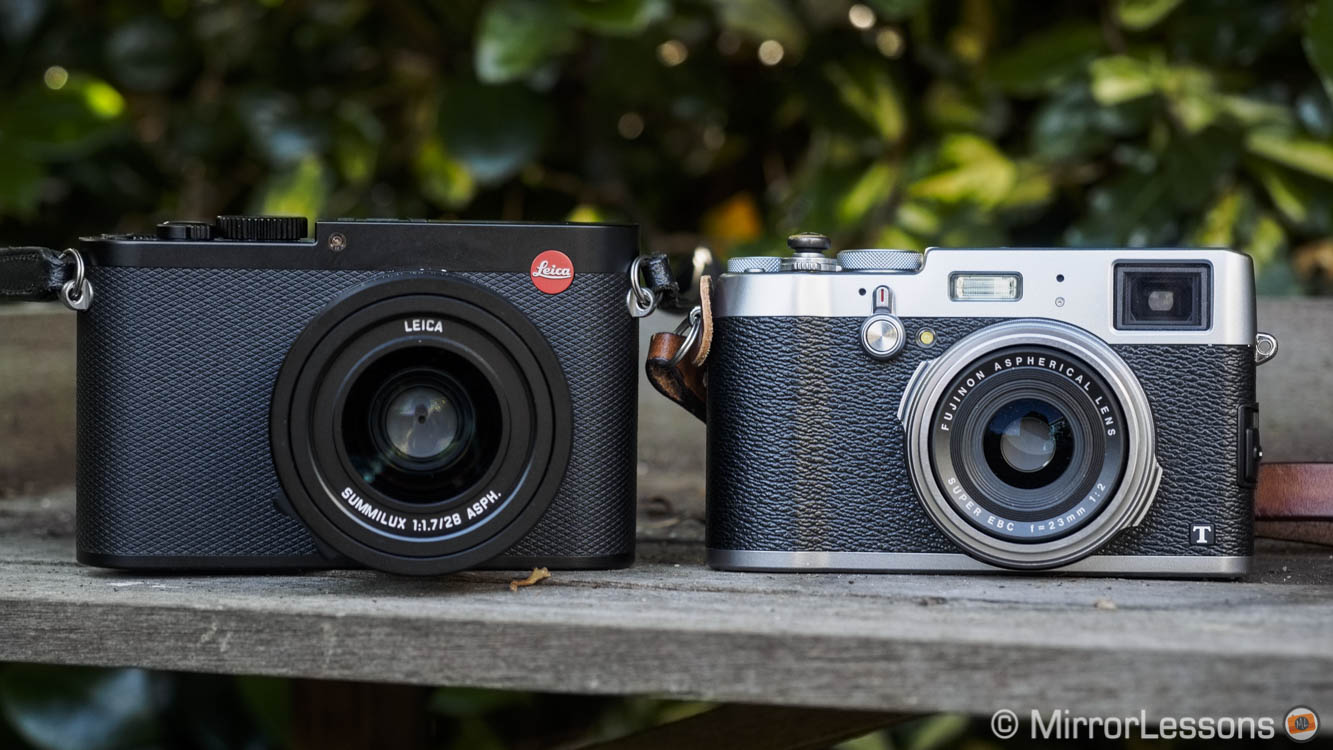I decided to make it clear right from the title that this is not a scientific comparison between two cameras with almost identical specs. On the contrary, the Leica Q and X100T don’t seem to have much in common at all except for one thing: they are the two premium compact cameras I’ve enjoyed using the most. The X100 series has long been my favourite for casual “everyday” photography. I just love the form factor and the quality you get from a such a small body. The Leica Q on the other hand is a camera I would probably not buy because of its price but I admit that I really enjoyed the time I spent with it thanks to the build quality, stunning 28mm lens and EVF.
Originally, I had planned to compare the Leica Q with the Sony RX1/r. Since they both have a full-frame sensor, it made perfect sense. Unfortunately, due to a number of circumstances involving scheduling and the non-availability of the two cameras at the same time, that comparison had to be cancelled. I certainly hadn’t thought about comparing the Q to the X100T at first. However, when I grabbed the Fujifilm camera again after sending the Q 116 back to Leica, I realised just how fond I am of both. I also recalled that one of the most popular articles on this website was our rather unconventional Olympus OM-D EM5 vs Fujifilm X100s post.
So, yes, in a way this is an apples vs. oranges comparison, but you’ve got to admit, it’s also more fun!
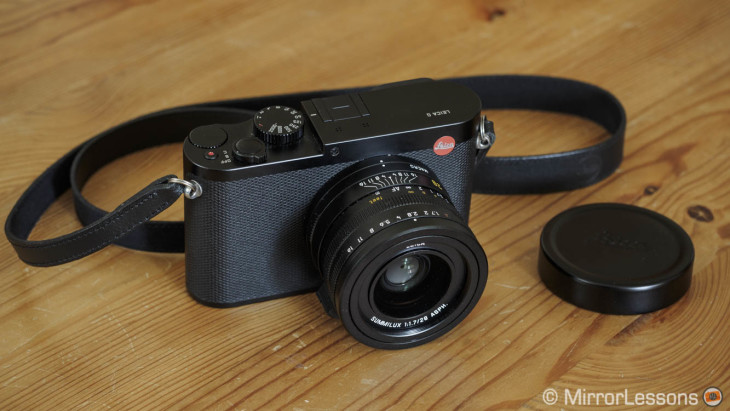
Leica Q (Typ 116)
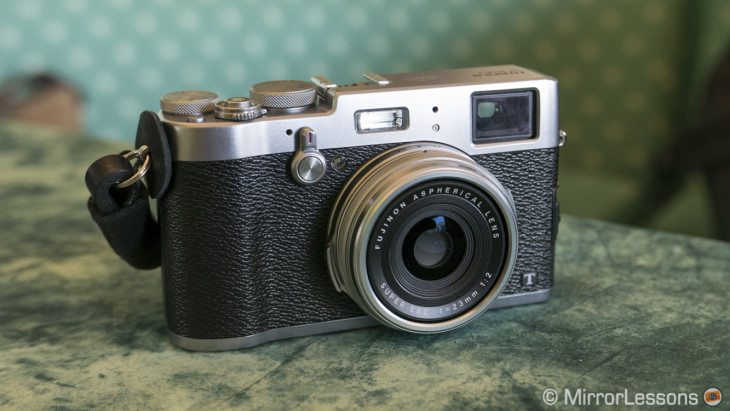
Fujifilm X100T
[toc heading_levels=”3″]
Ethics statement: We purchased the X100T to conduct our full reviews and comparisons while the Leica Q was loaned to us for a three week period. We were not asked to write anything about these cameras, nor were we provided any other compensation of any kind. Within the article, there are affiliate links. If you decided to buy something after clicking the link, we will receive a small commission. Don’t worry – prices remain the same for you. To know more about our ethics, you can visit our full disclosure page. Thank you!
In a nutshell: Main Specs
The two cameras feature different sensors with different sizes and resolution, as well as two different fixed prime lenses with different focal lengths. As you can see, this comparison kicks off with a challenge.
The Leica Q has a larger full-frame CMOS sensor with a Summilux 28mm f/1.7. The ISO range goes from 100 up to 25000 in both Raw and JPGs formats.
The X100T has an APS-C sensor with X-Trans technology and a 23mm f/2 lens that is the equivalent of a 35mm field of view by full-frame standards. The ISO sensitivity goes from 200 to 6400 with extended values up to 25600 (JPG only).
Both cameras offer manual controls with dials and rings that will please advanced photographers. They both have a good autofocus system although the Leica Q is faster and more reliable despite not having phase detection technology. Another relevant difference concerns the viewfinder.
The Leica Q has one of the best EVFs on the market with the highest resolution (3,680k dots). It is bright, very sharp and very easy to use when manual focusing with or without peaking.
The X100T features a hybrid EVF with both an electronic and optical option. It is one of the key features of this camera. It also has an electronic rangefinder that allows you to display a smaller electronic screen inside the OVF.
[expand title=”The Leica Q (Typ 116) Main Specs”]
- Sensor: 24 megapixel 35mm full frame CMOS
- Lens system: fixed Summilux 28mm f/1.7 ASPH
- Weatherproof: None
- Internal Stabilisation: Yes (Optical)
- Autofocus: Contrast detection AF with 49 autofocus areas
- Continuous shooting: 10 fps
- ISO Sensitivity: 100 – 50000 ISO
- Shutter Speeds: 1/2000 to 30 seconds, up to 1/16000s with electronic shutter
- Viewfinder: LCOS electronic viewfinder with 3,680k dots
- LCD Screen: fixed 3″ touch sensitive LCD monitor (1040k dots)
- Movie recording: Full HD up to 60fps
- Built-in Flash: No
- Extra Features: WiFi/NFC, Bracketing
- Dimensions: 130 x 80 x 93mm
- Weight: 640g (including battery and memory card)
[/expand]
[expand title=”The Fujifilm X100T Main Specs”]
- Sensor: 16.3 million pixels APS-C X-Trans CMOS II
- Lens system: fixed 23mm f/2 (35mm equivalent on full frame format)
- Weatherproof: No
- Internal Stabilisation: None
- Autofocus: Hybrid AF (TTL contrast AF / TTL phase detection AF) with 49 points
- Continuous shooting: 6 fps (High), 3 fps (Low)
- ISO Sensitivity: 200 – 6400 ISO (extended up to 51200, JPG only)
- Shutter Speeds: 1/4000 to 30 seconds, 1/32000s to 1s with electronic shutter
- Viewfinder: Hybrid Viewfinder: LCD electronic viewfinder with 2,360k dots, approx. 100% FOV coverage and 0.65x magnification / Optical VF (Reverse Galilean type) with 92% FOV coverage with ERF (Electronic Rangefinder)
- LCD Screen: fixed 3″ LCD monitor (1040k dots)
- Movie recording: 1920 x 1080 pixels (60fps to 24fps), manual controls
- Built-in Flash: yes
- Extra Features: WiFi, Panorama, Interval Time Shooting, Multiple exposure, Silent Mode
- Dimensions: 126.5 x 74.4 x 52.4mm
- Weight: 440g (including battery and memory card)
[/expand]
Design and Ergonomics
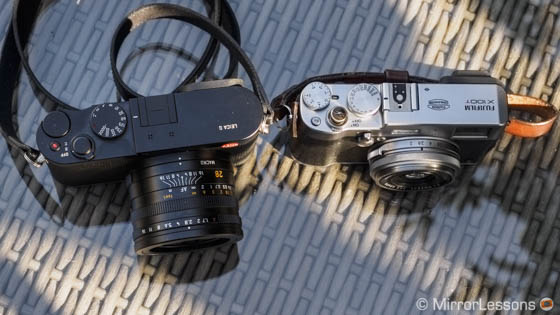
Despite Leica’s tradition of producing classic rangefinders, it is actually the X100T that looks more classic. The Q has a modern design while remaining very elegant. Which looks better is a question of personal taste.
When it comes to the ergonomics, the Q has a few advantages.
The Leica Q is slightly larger and definitely heavier. However the indented thumb rest on the rear and the larger lens on the front make it easier to hold and use.
The X100T is small and compact and as a result, the grip is somewhat sacrificed. I solved the problem with the Lensmate Thumb Rest that you can attach to the hot-shoe on top. Your grip on the lens is also more limited due to the lack of space.
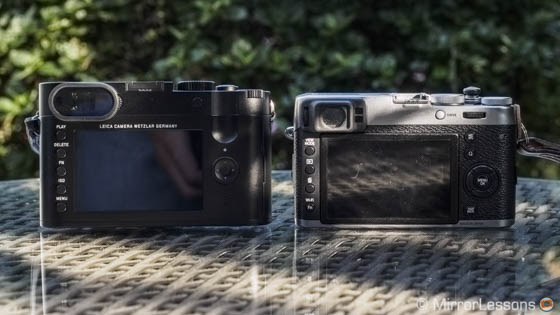
While reading one of Lloyd Chambers’ articles about the A7r mark II, a sentence in particular caught my attention. He states that “the Leica Q feels like the real thing”. Now you may agree with him or not, but I find it interesting that he specifically referred to the Leica Q and not another camera. When I grabbed the X100T to take the comparison shots for this article, it did feel more plasticky beside the Q than it would have on its own.
One of the strongest arguments in favour of Leica cameras has always been the build quality and I definitely won’t deny it. The Leica Q definitely feels stronger and more well-built. I think it has to do with the simplicity of it, at least seen from the outside. There are fewer parts – it looks like everything has been fashioned out of a single piece of robust aluminium. Even the thumb rest has been carved into the body, not attached. All the buttons on the rear feel nice and anything but cheap.
The build quality of the lens is also another point in favour of the Q.
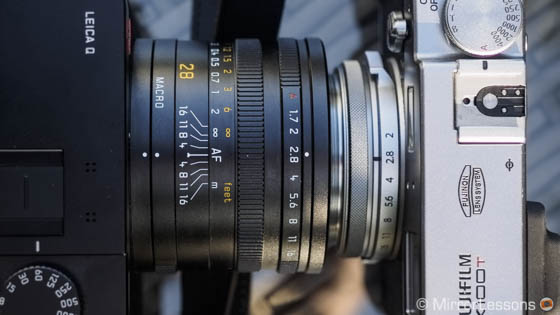
The 28mm Summilux has excellent focus and aperture rings that deliver true Leica mechanical precision (although I am not sure they are 100% mechanical). The ring that allows you to switch into macro mode is the cherry on top. It also changes the distance scale on the lens which is a neat thing to see.
The X100T has a focus ring that is “fly by wire” and you can tell this is the case when you compare it to the Leica camera. The aperture ring is good however and can be turned in 1/3 Ev steps. The only thing I don’t like about the aperture ring is that it is sometimes difficult to find while composing through the EVF since it sits close to the camera body.
Simplicity and the high quality build (even concerning the tiniest details) definitely make the Q the better option.
That said, I had the unfortunate chance to test the X100T’s robustness back in January when it fell on cold tarmac one winter morning.
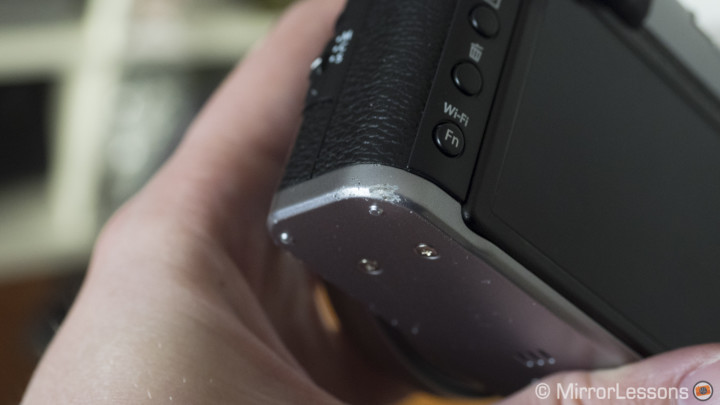
Despite the visible scratch and the hit, the camera still works fine even now. There are two possible explanations: I am either extremely lucky or the camera is indeed very robust despite the more plasticky feel . It also goes to show that what appears more fragile may indeed be solid enough. But if we’re talking about the quality of every single component, you can indeed feel a difference between the two cameras.
I would end this chapter by reminding you that neither of these cameras are weather-sealed. A few rain drops or dust won’t hurt them but it is best not to push your luck.
Ease of use
Excluding the main exposure settings that are all easily accessible, the two cameras have a different approach to the concept “ease of use”.
There are fewer possibilities to customise the Q. There are two Fn buttons but the functions you can assign to them are limited. So for certain settings like the AF mode or AF area you will need to access the main menu. Otherwise the camera is cleverly designed in terms of the button layout and you get used to it very quickly. You can switch to MF by unlocking the focus ring with the button on the lens thumb rest. The lens also includes a proper distance scale that makes hyperfocal adjustments much easier.
The Fujifilm X100T offers a good level of customisation with 7 Fn buttons and the option of controlling the arrow pad’s functions on the rear. The Quick menu allows you to rapidly change 16 settings that can also be customised. The bottom line is that between the dials, buttons and the Quick menu, everything is quickly accessible and you will rarely need to dig into the camera’s main menu. The AF/MF switch on the side is also very handy. The camera has a digital distance scale visible in the VF/LCD when manually focussing.
Neither camera has a tilting LCD screen, which would be a welcome feature. However the Leica Q has touch sensitive capabilities. You can change the focus point position and focus, take a shot, or quickly switch to playback mode by swiping up or down.
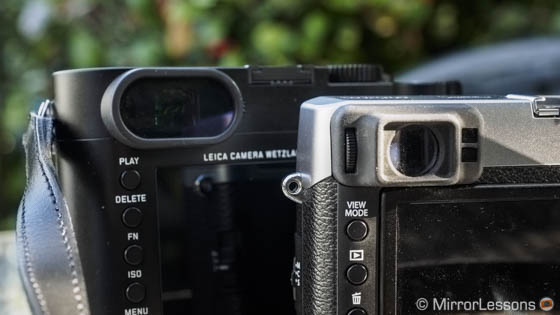
When it comes to the viewfinder, there are a few interesting points to consider.
The Leica Q “only” has an electronic viewfinder option but it is indeed one of the best on the market. It has a stunning resolution of 3,680k dots (the highest currently available). It uses LCOS technology and the resolution is actually divided between the 3 RGB colours (1,225k dots per colour). I find it to be very easy for manual focus with or even without focus peaking.
The X100T has an advanced hybrid viewfinder. It is one of the key selling points of this camera. With the electronic VF, you can of course see your exposure and picture effects in real time. There are several MF assists including Digital Spilt Image, a sort of digital version of the rangefinder mechanism. If you switch to the optical viewfinder, you can benefit from a real-time parallax correction and activate the ERF (Electronic Rangefinder) that will show you a digital magnified portion of your frame in the bottom right-hand corner.
While the technology in the X100T viewfinder is definitely interesting, I admit that most of the time I tend to use the electronic version. I admit that I am not totally seduced by either the OVF or ERF options. The Leica Q has a better EVF and it is extra proof that electronic VFs are getting better and better. I am very used to them now and I don’t miss optical finders. So while the X100T offers you more options, my personal preference goes to the Leica Q.
[stextbox id=”text-box-toc” caption=”Table of Contents” collapsing=”true” collapsed=”true”]
- In a nutshell: Main Specs
- Design and Ergonomics
- Ease of use
- Image Quality: sensor
- Image Quality: Lens
- Autofocus and performance
- Video and extras
- Conclusion
[/stextbox]
Image Quality: sensor


Some might think that comparing a full-frame sensor to an APS-C sensor is not fair. However I like to consider things from a different perspective.
I have the chance to test many cameras and I admit that today it is increasingly rare to find a sensor that performs poorly. It is also rarer and rarer to see a new sensor capable of obliterating the previous one. For example, the new 20MP Micro Four Thirds sensor in the Panasonic GX8 didn’t impress me in comparison to the standard 16MP sensor found in many MFT cameras. Even the new A7r mark II sensor that was recently proclaimed the best full-frame chip on the planet is, for me, a nice upgrade from the previous 36MP sensor of the A7r II but not much else.
Now let’s go back to our two cameras and start breaking the rules. We would naturally think that the 24MP full-frame sensor of the Leica Q has better dynamic range than the 16MP APS-C sensor. However, in this case, the Q doesn’t have a big advantage in terms of DR and this has mainly to do with the limited versatility of the DNG (Raw) files. If you attempt to recover shadows too much, banding can appear. That doesn’t happen with the X100T and many other sensors I’ve tested.
The example below shows the same scene photographed with the two cameras. There are very minor differences. The Leica Q has retained slightly more detail in the highlights.


However if I try to push the shadows too much with the Q file (+2Ev, + 50 shadows), banding becomes visible in the shadows while the X100T file displays some noise but not banding when pushed the same way.
- Slide to the right to see the Leica Q crop (full size version here)
- Slide to the left to see the X100T crop (full size version here)
[twentytwenty]


[/twentytwenty]
Here you can see a more evident example of the banding issue with the Leica Q.
When it comes to low-light capabilities, both have their strengths and weaknesses.
The Leica Q allows you to shoot up to 25000 in both Raw and JPG formats and the camera has excellent performance up to 6400 ISO as far as noise and details is concerned. However past 3200 ISO you can find some minor banding again depending on the light. It becomes more visible from 12800. Another thing is that at high ISOs, slow shutter speeds are limited. For example, at 3200 and 6400 ISO, you can’t go slower than 4s. This can be a limit for astrophotography, which might not be the primary genre this camera was designed for but given its excellent and fast wide angle lens, it is a shame to have a limitation that clearly is a sensor/processor issue.


I find the X100T usable up to 6400 ISO and as a matter of fact I have used Fujifilm cameras at that sensitivity many times. The amount of details retained is lower however and the images look slightly softer in comparison. I also wish I could use the highest ISOs available (12800 and 25600) with the Raw files instead of only JPG. For this reason, I very rarely shoot past 6400 with this camera.


Here you can check out a direct ISO comparison between the two cameras.
When it comes to colour, I admit I have a harder time choosing which one I prefer. This is because, out of all digital cameras, the respective colour palettes from the Q and Fujifilm are my favourite. What’s more, the colours sometimes look quite similar.
The Leica Q has a very natural rendering, probably the best I’ve seen along with the M 240. So despite the sensor presenting some weaknesses, the Q has an excellent colour palette. There aren’t different picture profiles available but rather basic settings for contrast, saturation and sharpness that will affect the JPGs. There is also a monochrome profile that delivers excellent results.
I have praised Fujifilm colours for a long time and it is not a surprise that it is among the aspects Fuji users like the most. The brand put a lot of work into creating different picture profiles (called Film Simulation modes), some of which will please documentary and working photographers (the latest addition, Classic Chrome, is the perfect example). The camera also includes different monochrome presets that I find very nice to use.
Below you can see the same scene shot with the two cameras. With the X100T, I used the standard (Provia) profile. You may notice that the colours are in fact very similar.


The X100T however offers more picture profiles. Below is the same scene shot with Classic Chrome.

Here is another example with some warmer colours.


A few words concerning sharpness and detail: my overall preference goes to the Leica Q. Of course this is an aspect that is also affected by the optical quality of the lens (more on that later). Both sensors lack an AA filter but the Q in combination with its lens delivers sharper results in my opinion. Details are crisper and more defined. Also the DNG files of the Q are easy to read by most post processing softwares while Fuji’s RAF file can have a softer rendering with Adobe programs. However if I open them with the right tool such as Iridient, the sharpness and detail of the Fuji files can be very good as well.
Image Quality: Lens
Here come the main difference between these two cameras. It is not just a matter of optical quality but also which fixed focal length you prefer.
The Leica Q has a fixed 28mm Summilux lens and I admit that 28mm is not my favourite focal length. This is one of the reasons I am also reluctant to use this camera for personal use – I am not sure I would enjoy it as much as I would with a different focal length.
The X100T has a 23mm (35mm equivalent on full-frame) lens, which is an angle of view I prefer. The camera also has two optional converters, the WCL-X100 (28mm equivalent) and TXL-X100 (50mm equivalent) so it can be seen as a mini system with three useful focal lengths and therefore more versatility.
When it comes to optical performance, the Leica Q has a clear advantage. Not only it is slightly faster (f/1.7 vs f/2) but it is also sharper wide open, has a more interesting bokeh rendering and also has more “character”. The transition between in focus and out of focus elements is smoother.

A good example of the sharpness and shallow depth of field capabilities of the Leica Q.
The 23mm lens on the X100 series “does the job” but it isn’t the most stunning aspect of the camera when it comes to overall image quality. The difference in lens construction and size should also be noted.

A similar scene (but different light and subject) shows that the bokeh capabilities are more limited.
Both lenses do well at minimising chromatic aberration (certainly helped by the camera’s processor as well) but aren’t completely flare free, although the Leica Q can have more visible and invasive flares like in the example below. The only flaw I found with the 28mm Summilux is some barrel distortion.

Flare example.

Flare example
Both lenses offer semi-macro capabilities but I would give the advantage to the X100T since it can focus closer (10cm vs 17cm) and has a narrower angle of view.
[stextbox id=”text-box-toc” caption=”Table of Contents” collapsing=”true” collapsed=”true”]
- In a nutshell: Main Specs
- Design and Ergonomics
- Ease of use
- Image Quality: sensor
- Image Quality: Lens
- Autofocus and performance
- Video and extras
- Conclusion
[/stextbox]
Autofocus and performance
The Leica Q is the first camera by the German brand that has excellent AF capabilities. As a matter of fact, it is also one of the best AF mechanisms I’ve tried on a mirrorless camera. But first, let’s look at the specs.

The Leica Q has 49 AF points but lacks phase detection technology. You can choose between Single and Multi as well as Tracking and Face detection. You can also use the touch screen to focus and take a shot. The camera can shoot at 10fps in S-AF and 4/5fps in C-AF.
The X100T has a hybrid contrast/phase detection AF system with 40 contrast points and 9 phase points at the centre. You can choose between Single and Multi area mode and it also has face detection AF. It can shoot up to 6fps in C-AF and has two different AF modes.
Overall both cameras perform well but the Leica Q definitely feels faster and more reactive. It also performs better in low light. The X100T sometimes tends to be slower at locking onto a subject and occasionally fails to lock (it is better to use the smallest AF point in S-AF). They are not action cameras but both can do well in C-AF and continuous shooting. The X100T has more limited buffer capabilities.

Both cameras have a mechanical leaf shutter which results in a quieter shutter sound and higher speed sync with flashes. They also have an electronic version.
The Q can shoot up to 1/2000s with the mechanical shutter but is limited to 1/500s with flash. With the electronic shutter it goes up to 1/16000s. It works automatically and activates when you go past the 1/2000s speed.
The Fujifilm X100T can shoot up to 1/4000s (including flash synchronisation) and up to 1/32000s with the electronic shutter. It has a silent mode and the electronic shutter can be activated at any time. You can also benefit from the built-in ND filter (3Ev of compensation).
Finally, the Leica also has the advantage of optical stabilisation while the X100T lacks any sort of stabilisation compensation. With the Q, I can shoot down to 1/5s more or less and get sharp results. With the X100T, I wouldn’t go past 1/13s.
The battery life isn’t great on either camera. A second spare battery is advised to get through an entire day of shooting.
Video and extras
Neither camera is known for its video capabilities. They both offer manual controls and a decent Full HD video quality but aliasing and moiré can be quite present. Here again the Leica Q has something more when it comes to video: the AF works better and you get software stabilisation in addition to the OIS.
When it comes to extra shooting modes and features, neither camera has the richest offerings.
The Leica Q offers bracketing up to 3 shots and 3Ev of difference. You get a panorama and time-lapse function. There is an advanced crop mode that emulates the 35mm and 50mm field of view while maintaining the original composition on the display and showing the bright frames common on rangefinder cameras so that you can see outside of your composition.
With the X100T you get built-in panorama, multiple exposures and various bracketing options. Unfortunately exposure bracketing is limited to only 3 shots at 1Ev. There is an intervalometer built in for timelapse shots.
A final word goes to the wireless capacities. They both have Wifi and the Leica Q also has NFC. You can remotely control the camera or transfer images using a mobile device. Both apps are well designed and work well with good and solid connectivity.
[stextbox id=”text-box-toc” caption=”Table of Contents” collapsing=”true” collapsed=”true”]
- In a nutshell: Main Specs
- Design and Ergonomics
- Ease of use
- Image Quality: sensor
- Image Quality: Lens
- Autofocus and performance
- Video and extras
- Conclusion
[/stextbox]
Conclusion

It is difficult to conclude this comparison without mentioning the price. The Leica Q costs 4 times as much as the X100T which easily makes the Fujifilm option the best bang for your buck. The Fujifilm X100T has a very good sensor despite not being full frame, is a very pleasant camera to use with more customisation options, and incorporates unique hybrid viewfinder technology. The AF can struggle at times and the lens is good but isn’t the camera’s main selling point.

To condemn the Leica Q just for the price would be a little bit unfair. It proved an excellent camera in many ways. Its most interesting aspects are definitely the 3,680k dot EVF and the stunning 28mm Summilux. The grip is excellent, as well as the overall build quality. The autofocus is one of the best I’ve tried. I wish the camera could include a few more customisation options and some extra features such as an intervalometer. And despite the excellent colour rendition and the full-frame look, the banding problem when you recover shadows or limitation at high ISOs is its main weak point in terms of overall image quality.
Choose the Leica Q Typ 116 if:
- You want a premium build
- You really like the 28mm focal length
- You want better optical quality
- You want one of the best EVFs on the market
- You want a reliable and very fast autofocus
Choose the Fujifilm X100T if:
- You want to spend less (four times less)
- You like optical rangefinders
- You like the 35mm (equivalent) field of view
- You want more options and customisation
- You like the idea of more than one focal length (optical converters are available)
If you are interested in finding out more about the two cameras, you can check out the following articles.
